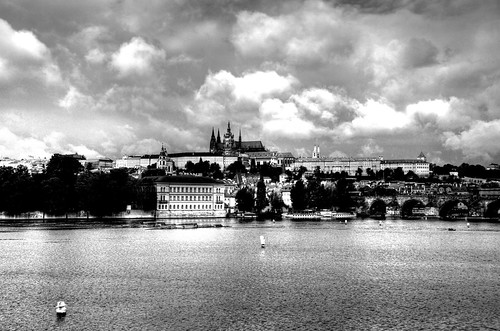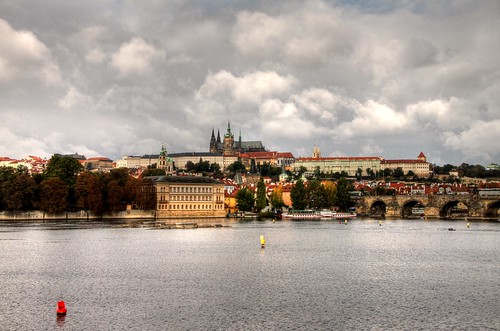

Στην Ελλάδα τον ξέρουμε ως "Μολδάβα", η οποία είναι η εξελληνισμένη μορφή του γερμανικού ονόματος "Moldau". Στην Τσεχία είναι γνωστός ως Vltava (Βλτάβα) και είναι ο ποταμός που διαρρέει την πρωτεύουσα της, Praha (Πράγα). Πηγάζει από τον Βοημικό Δρυμό σε υψόμετρο 1.172 μέτρων και ρέει προς τα βόρεια καταλήγοντας στον ποταμό Έλβα...
Το γνωστότερο ίσως συμφωνικό ποίημα του κλασικού Τσέχου μουσικοσυνθέτη Bedřich Smetana (Μπέντριχ Σμέτανα), ένα από τα 6 της συλλογής "Má Vlast" (Η Πατρίδα μου), είναι το "Vltava", ευρύτερα γνωστό και με την Γερμανική ονομασία "Die Moldau", το οποίο και αναπαριστά με μουσική την πορεία του ποταμού, από τις πηγές του, όπου μικρά ρυάκια συνενώνονται, μέχρι το τέλος της διαδρομής του. Ξεκινάει από τις δύο μικρές πηγές, την κρύα και την ζεστή Βλτάβα, και συνεχίζει με την ενοποίηση των δύο ρευμάτων σε ένα ενιαίο... Περιγράφει την πορεία του Μολδάβα μέσα σε δάση και λιβάδια, μέσα από τοπία όπου γίνεται το γλέντι του γάμου ενός γεωργού... Περιγράφει τον κυκλικό χορό των νυμφών κάτω από το φεγγαρόφωτο ενώ στα κοντινά βράχια υψώνονται περήφανα κάστρα, παλάτια και ερείπια ψηλά. Στροβιλίζεται στο ρεύμα του Αγίου Ιωάννη... Απλώνεται και διαρρέει την Πράγα, περνάει το Vyšehrad, και στη συνέχεια εξαφανίζεται μεγαλοπρεπώς καταλήγοντας στον Έλβα...
Το γνωστότερο ίσως συμφωνικό ποίημα του κλασικού Τσέχου μουσικοσυνθέτη Bedřich Smetana (Μπέντριχ Σμέτανα), ένα από τα 6 της συλλογής "Má Vlast" (Η Πατρίδα μου), είναι το "Vltava", ευρύτερα γνωστό και με την Γερμανική ονομασία "Die Moldau", το οποίο και αναπαριστά με μουσική την πορεία του ποταμού, από τις πηγές του, όπου μικρά ρυάκια συνενώνονται, μέχρι το τέλος της διαδρομής του. Ξεκινάει από τις δύο μικρές πηγές, την κρύα και την ζεστή Βλτάβα, και συνεχίζει με την ενοποίηση των δύο ρευμάτων σε ένα ενιαίο... Περιγράφει την πορεία του Μολδάβα μέσα σε δάση και λιβάδια, μέσα από τοπία όπου γίνεται το γλέντι του γάμου ενός γεωργού... Περιγράφει τον κυκλικό χορό των νυμφών κάτω από το φεγγαρόφωτο ενώ στα κοντινά βράχια υψώνονται περήφανα κάστρα, παλάτια και ερείπια ψηλά. Στροβιλίζεται στο ρεύμα του Αγίου Ιωάννη... Απλώνεται και διαρρέει την Πράγα, περνάει το Vyšehrad, και στη συνέχεια εξαφανίζεται μεγαλοπρεπώς καταλήγοντας στον Έλβα...

Για το "Vltava", ο Σμετάνα διασκεύασε την μελωδία της "La Mantovana" του Giuseppino del Biado, ενός Ιταλικού τραγουδιού του 16ου αιώνα, το οποίο ήταν ευρέως διαδεδομένο στην Αναγεννησιακή Ευρώπη... H μελωδία της "La Mantovana" βρίσκεται στην ρίζα πολλών φολκλορικών τραγουδιών πολλών χωρών της Ευρώπης, όπως της Ιταλίας, της Ρουμανίας, της Μολδαβίας, και της Ουκρανίας...
Την διασκευή του Σμετάνα χρησιμοποίησε και ο Εβραίος έποικος από την Μολδαβία, Samuel Cohen, για να φτιάξει την μουσική του Ισραηλινού Εθνικού Ύμνου, ο οποίος είναι γνωστός ως "הַתִּקְוָה" (Χατίκβα - "Η Ελπίδα").
Εγώ έχω την εντύπωση ότι αναγνωρίζω την μελωδία της "La Mantovana" στην μουσική της Λίνας Νικολακοπούλου για το τραγούδι του Λαυρέντη Μαχαιρίτσα "Ο Σουλτάνος της Βαβυλώνας και η Γυναίκα"...
[ENG] In Greece we know this river as "Moldava", which is the Hellenized form of the German name "Moldau". In Czech Republic it is known as "Vltava" and it is the river that runs through its capital, Praha (Prague). It comes from the Bohemian Forest, from an altitude of 1172 meters, and flows northwards reaching the river Elba... The most famous, perhaps, symphonic poem, of the classical Czech composer Bedřich Smetana, one of the 6 of the collection "Má Vlast" (My homeland) is the "Vltava", widely known also by its German name "Die Moldau", which represents with music the course of the river from its source, where small streams are combined to one main stream till the end of its journey. As Smetana himself said "The composition describes the course of the Vltava, starting from the two small springs, the Cold and Warm Vltava, to the unification of both streams into a single current, the course of the Vltava through woods and meadows, through landscapes where a farmer's wedding is celebrated, the round dance of the mermaids in the night's moonshine: on the nearby rocks loom proud castles, palaces and ruins aloft. The Vltava swirls into the St. John's Rapids; then it widens and flows toward Prague, past the Vyšehrad, and then majestically vanishes into the distance, ending at the Labe (or Elbe in German)." Smetana had adapted, for the "Vltava", the melody from "La Mantovana" of Giuseppino del Biado, an Italian song of the 16th century, which was widespread in Renaissance Europe... The melody of "La Mantovana" is in the root of many folkloric songs of many countries in Europe such as Italy, Romania, Moldova and Ukraine... The adaptation of Smetana was later used by the Jewish settler from Moldova, Samuel Cohen, to create the music of the Israeli National Anthem, which is known as "הַתִּקְוָה" (Hatikvah - "The Hope"). Personally, I have the impression that I recognize the melody of "La Mantovana" in Lina Nikolakopoulou's music for the song of Lavrentis Macheritsas "The Sultan of Babylon and the Woman". Songs: [1.] Bedřich Smetana "Vltava", [2.] Hatikvah (Israel's National Anthem), [3.] Lavrentis Macheritsas "The Sultan of Babylon and the Woman"...
Την διασκευή του Σμετάνα χρησιμοποίησε και ο Εβραίος έποικος από την Μολδαβία, Samuel Cohen, για να φτιάξει την μουσική του Ισραηλινού Εθνικού Ύμνου, ο οποίος είναι γνωστός ως "הַתִּקְוָה" (Χατίκβα - "Η Ελπίδα").
Εγώ έχω την εντύπωση ότι αναγνωρίζω την μελωδία της "La Mantovana" στην μουσική της Λίνας Νικολακοπούλου για το τραγούδι του Λαυρέντη Μαχαιρίτσα "Ο Σουλτάνος της Βαβυλώνας και η Γυναίκα"...
[ENG] In Greece we know this river as "Moldava", which is the Hellenized form of the German name "Moldau". In Czech Republic it is known as "Vltava" and it is the river that runs through its capital, Praha (Prague). It comes from the Bohemian Forest, from an altitude of 1172 meters, and flows northwards reaching the river Elba... The most famous, perhaps, symphonic poem, of the classical Czech composer Bedřich Smetana, one of the 6 of the collection "Má Vlast" (My homeland) is the "Vltava", widely known also by its German name "Die Moldau", which represents with music the course of the river from its source, where small streams are combined to one main stream till the end of its journey. As Smetana himself said "The composition describes the course of the Vltava, starting from the two small springs, the Cold and Warm Vltava, to the unification of both streams into a single current, the course of the Vltava through woods and meadows, through landscapes where a farmer's wedding is celebrated, the round dance of the mermaids in the night's moonshine: on the nearby rocks loom proud castles, palaces and ruins aloft. The Vltava swirls into the St. John's Rapids; then it widens and flows toward Prague, past the Vyšehrad, and then majestically vanishes into the distance, ending at the Labe (or Elbe in German)." Smetana had adapted, for the "Vltava", the melody from "La Mantovana" of Giuseppino del Biado, an Italian song of the 16th century, which was widespread in Renaissance Europe... The melody of "La Mantovana" is in the root of many folkloric songs of many countries in Europe such as Italy, Romania, Moldova and Ukraine... The adaptation of Smetana was later used by the Jewish settler from Moldova, Samuel Cohen, to create the music of the Israeli National Anthem, which is known as "הַתִּקְוָה" (Hatikvah - "The Hope"). Personally, I have the impression that I recognize the melody of "La Mantovana" in Lina Nikolakopoulou's music for the song of Lavrentis Macheritsas "The Sultan of Babylon and the Woman". Songs: [1.] Bedřich Smetana "Vltava", [2.] Hatikvah (Israel's National Anthem), [3.] Lavrentis Macheritsas "The Sultan of Babylon and the Woman"...








No comments:
Post a Comment